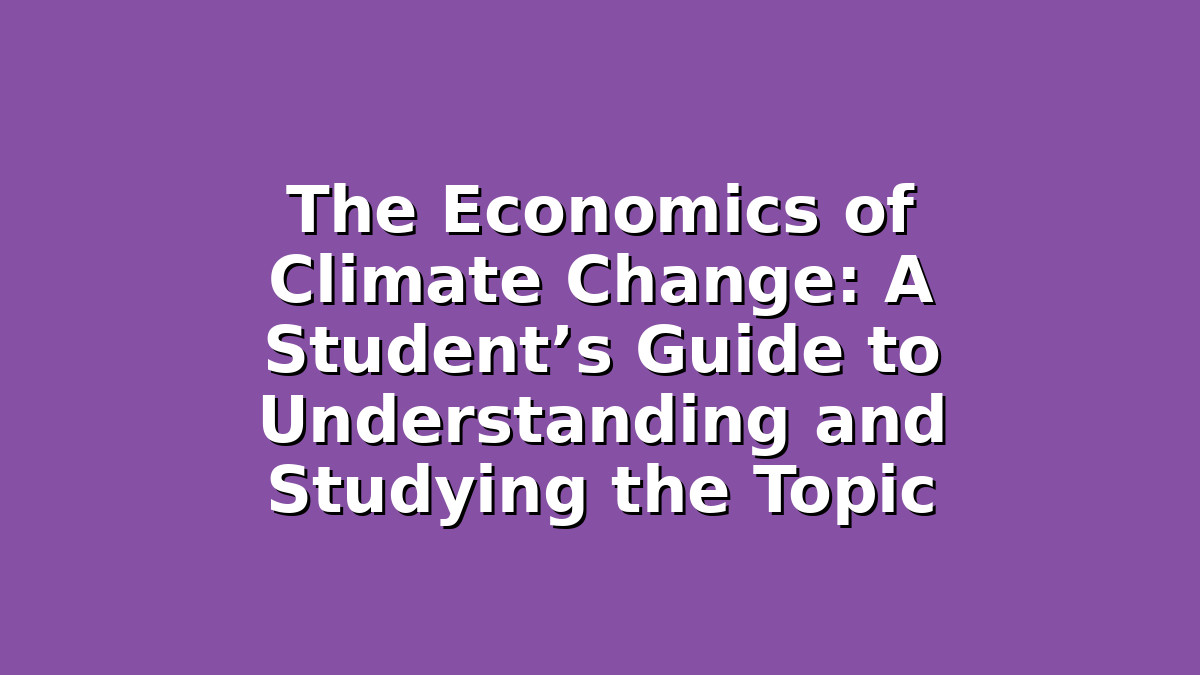Climate change is one of the most pressing issues facing our world today, and its economic implications are vast and complex. For students preparing for exams or looking to deepen their understanding of this critical subject, grasping the economics of climate change can be both challenging and rewarding. This blog post will explore the key economic concepts related to climate change and provide practical study tips to help you excel in your coursework.
Introduction
Economics and climate change might seem like two very different fields, but they are deeply intertwined. Climate change affects economies worldwide through impacts on agriculture, health, infrastructure, and energy systems. At the same time, economic policies and market mechanisms play a crucial role in mitigating or exacerbating climate change. For students, understanding this relationship is essential—not only for academic success but also for becoming informed global citizens.
In this guide, we’ll break down the economics of climate change into manageable parts, explain important concepts, and share study strategies tailored to help you retain information and perform well on exams.
—
1. Understanding the Economic Impacts of Climate Change
To begin, it’s important to understand how climate change affects economies at different levels. The economic impacts can be direct or indirect, local or global, short-term or long-term.
Key Concepts to Focus On:
– Externalities: Climate change is a negative externality, meaning its costs are not reflected in the market prices of goods and services that produce greenhouse gases. Understanding externalities helps explain why governments intervene with policies.
– Cost of Damage: Extreme weather events, rising sea levels, and shifting agricultural productivity can cause billions in damages. These costs strain public budgets and reduce economic growth.
– Sectoral Impacts: Some industries, like agriculture, tourism, and insurance, are particularly vulnerable, while others might benefit in the short run (e.g., shipping routes opening due to melting ice).
Study Tip: Create mind maps linking climate impacts to economic consequences. Visualizing these connections can help you remember details and see the bigger picture.
Example: Consider how droughts reduce crop yields, leading to higher food prices and impacting both consumers and producers. Linking this cause and effect clarifies the real-world relevance of economic theories.
—
2. Economic Policies and Tools to Address Climate Change
Once you understand the impacts, the next step is to learn about the economic tools used to combat climate change. Governments and organizations use various policies to manage emissions and encourage sustainable practices.
Important Topics to Cover:
– Carbon Pricing: This includes carbon taxes and cap-and-trade systems, designed to internalize the external costs of pollution. Know how these mechanisms work and their advantages and limitations.
– Subsidies and Incentives: Governments might subsidize renewable energy or electric vehicles to encourage cleaner alternatives.
– Cost-Benefit Analysis: Economists use this tool to weigh the costs of climate policies against their benefits, helping policymakers make informed decisions.
Study Tip: Practice explaining these policies in your own words and use real-world examples. For instance, research how the European Union’s Emissions Trading System functions or how carbon taxes have been implemented in countries like Sweden or Canada.
Example: Writing a brief summary or teaching a peer about carbon taxes will reinforce your understanding and prepare you for exam questions requiring explanation or evaluation.
—
3. Integrating Climate Change Economics into Your Study Routine
Economics and climate change are broad subjects, so it’s important to organize your study effectively.
Effective Strategies:
– Break Down Information: Divide your study materials into sections such as “Economic Impacts,” “Policy Responses,” and “Global Cooperation.” Focus on mastering one section at a time.
– Use Past Papers and Practice Questions: These help you get familiar with the types of questions asked and improve your time management.
– Stay Updated: Climate economics is a dynamic field. Follow reputable news sources, economic reports, and scientific updates to bring current examples into your answers, impressing examiners.
– Group Study: Discussing ideas with classmates can deepen your understanding and expose you to different perspectives.
Study Tip: Create flashcards with key terms and definitions related to climate economics (e.g., “negative externality,” “carbon market”). Regularly quiz yourself to reinforce memory.
Example: Dedicate weekly study sessions to reviewing new research or policy developments related to climate economics. This habit will help you connect theory with real-world practice and develop critical thinking skills.
—
Conclusion
Studying the economics of climate change is not only about memorizing facts but also about understanding complex relationships between environmental changes and economic systems. By focusing on the economic impacts, policy tools, and effective study habits, you can build a solid foundation that will help you succeed in exams and beyond.
Remember, this topic is highly relevant to the future of our planet, so your efforts to learn and understand it are valuable in multiple ways. Stay curious, stay organized, and don’t hesitate to seek help from teachers or peers when you encounter difficult concepts. With dedicated study and a positive mindset, you can master the economics of climate change and contribute to the global conversation on sustainability.
Good luck with your studies—you’ve got this!
—

Responses